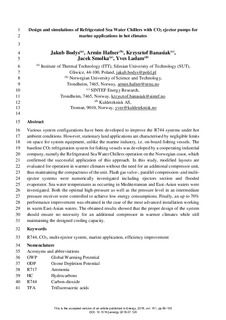| dc.contributor.author | Bodys, Jakub | |
| dc.contributor.author | Hafner, Armin | |
| dc.contributor.author | Banasiak, Krzysztof | |
| dc.contributor.author | Smolka, Jacek | |
| dc.contributor.author | Ladam, Yves | |
| dc.date.accessioned | 2019-02-12T17:22:27Z | |
| dc.date.available | 2019-02-12T17:22:27Z | |
| dc.date.created | 2018-11-16T09:24:50Z | |
| dc.date.issued | 2018 | |
| dc.identifier.citation | Energy. 2018, 161 90-103. | nb_NO |
| dc.identifier.issn | 0360-5442 | |
| dc.identifier.uri | http://hdl.handle.net/11250/2585101 | |
| dc.description.abstract | Various system configurations have been developed to improve the R744 systems under hot ambient conditions. However, stationary land applications are characterised by negligible limits on space for system equipment, unlike the marine industry, i.e. on-board fishing vessels. The baseline CO2 refrigeration system for fishing vessels was developed by a cooperating industrial company, namely the Refrigerated Sea Water Chillers operation on the Norwegian coast, which confirmed the successful application of this approach. In this study, modified layouts are evaluated for operation in warmer climates without the need for an additional compressor unit, thus maintaining the compactness of the unit. Flash gas valve-, parallel compression- and multi-ejector systems were numerically investigated including ejectors section and flooded evaporator. Sea water temperatures as occurring in Mediterranean and East-Asian waters were investigated. Both the optimal high-pressure as well as the pressure level in an intermediate pressure receiver were controlled to achieve low energy consumptions. Finally, an up to 70% performance improvement was obtained in the case of the most advanced installation working in warm East-Asian waters. The obtained results showed that the proper design of the system should ensure no necessity for an additional compressor in warmer climates while still maintaining the designed cooling capacity. | nb_NO |
| dc.language.iso | eng | nb_NO |
| dc.publisher | Elsevier | nb_NO |
| dc.rights | Attribution-NonCommercial-NoDerivatives 4.0 Internasjonal | * |
| dc.rights.uri | http://creativecommons.org/licenses/by-nc-nd/4.0/deed.no | * |
| dc.title | Design and simulations of refrigerated sea water chillers with CO2 ejector pumps for marine applications in hot climates | nb_NO |
| dc.type | Journal article | nb_NO |
| dc.type | Peer reviewed | nb_NO |
| dc.description.version | acceptedVersion | nb_NO |
| dc.source.pagenumber | 90-103 | nb_NO |
| dc.source.volume | 161 | nb_NO |
| dc.source.journal | Energy | nb_NO |
| dc.identifier.doi | 10.1016/j.energy.2018.07.126 | |
| dc.identifier.cristin | 1631291 | |
| cristin.unitcode | 7548,70,0,0 | |
| cristin.unitname | Termisk energi | |
| cristin.ispublished | true | |
| cristin.fulltext | postprint | |
| cristin.qualitycode | 2 | |

